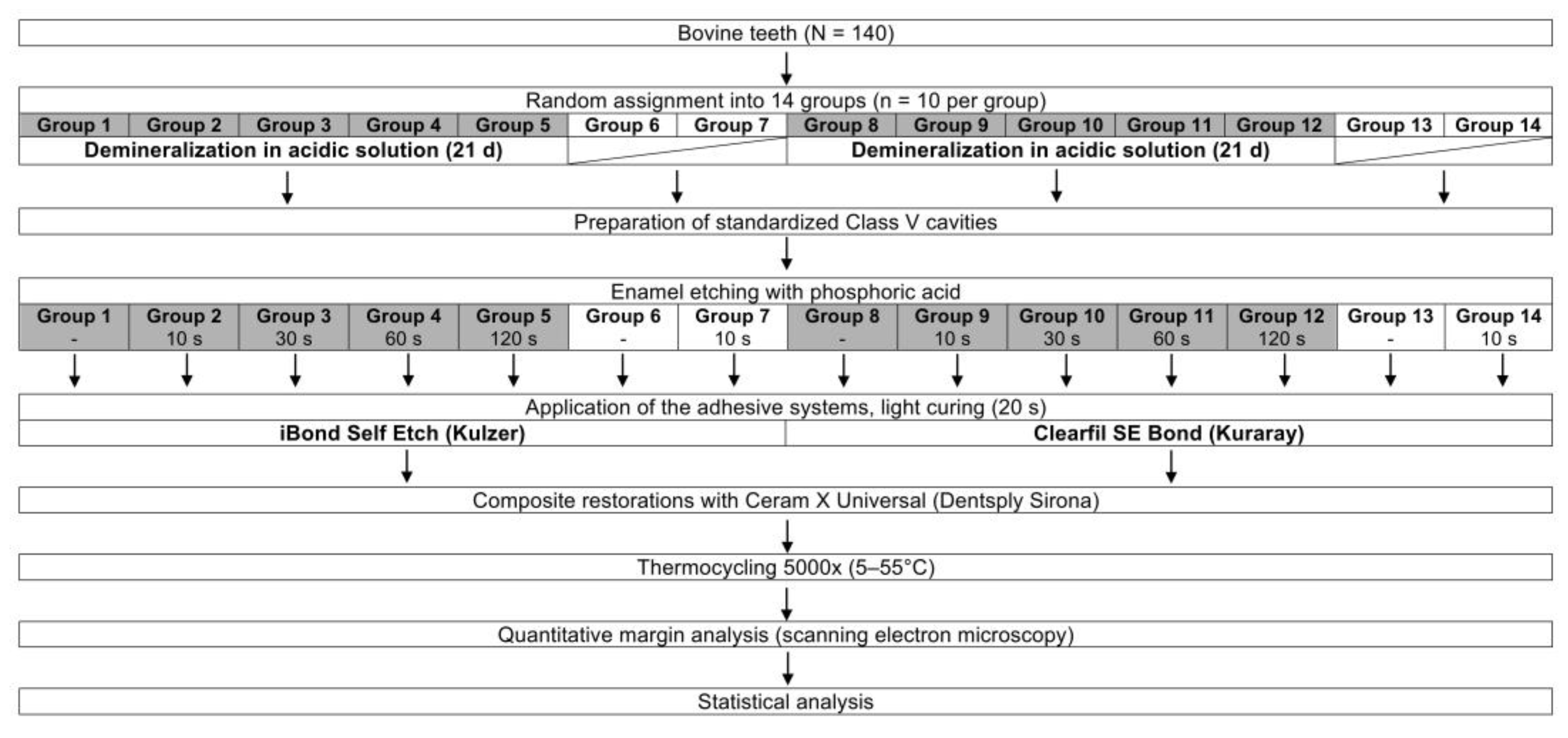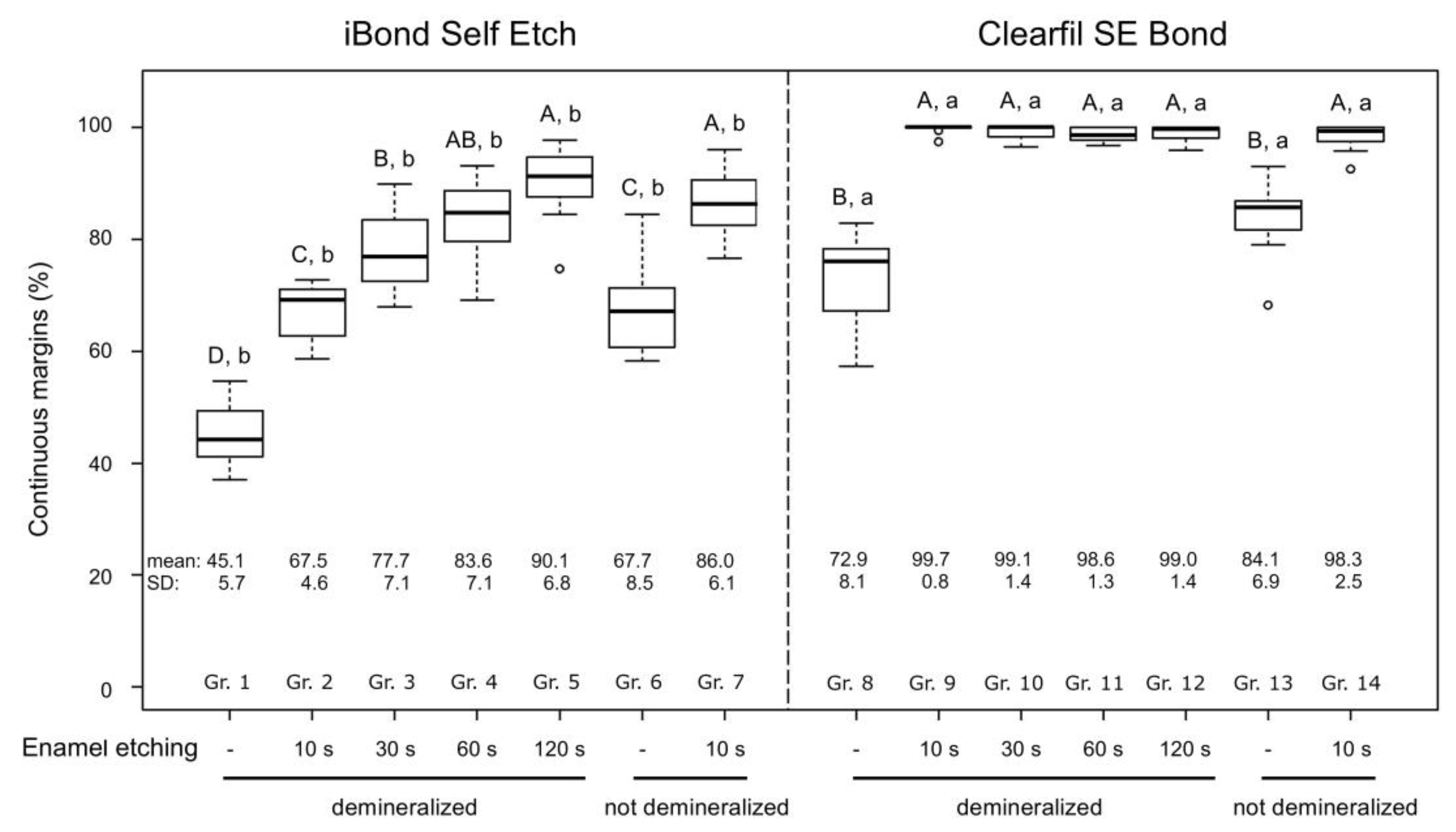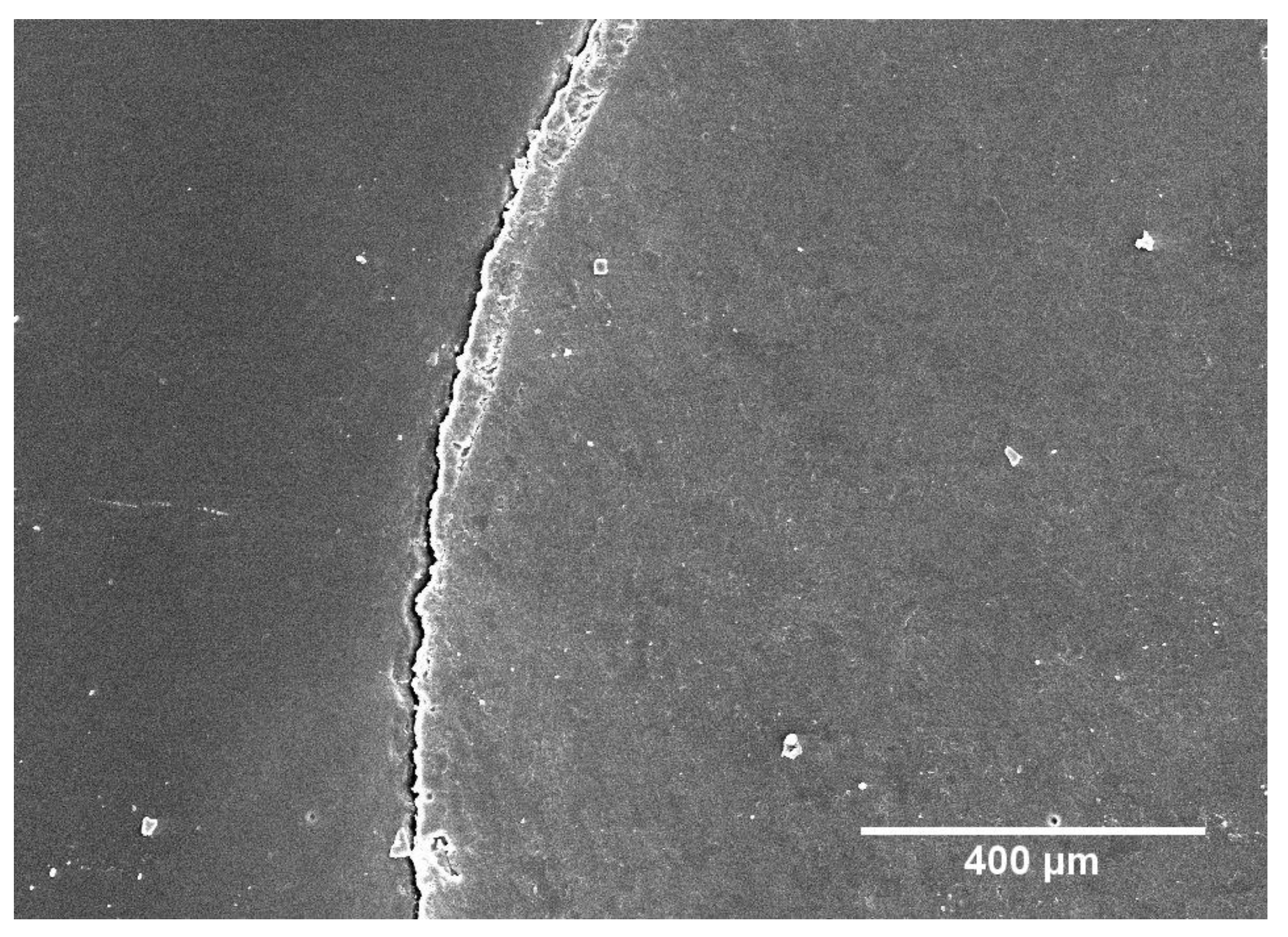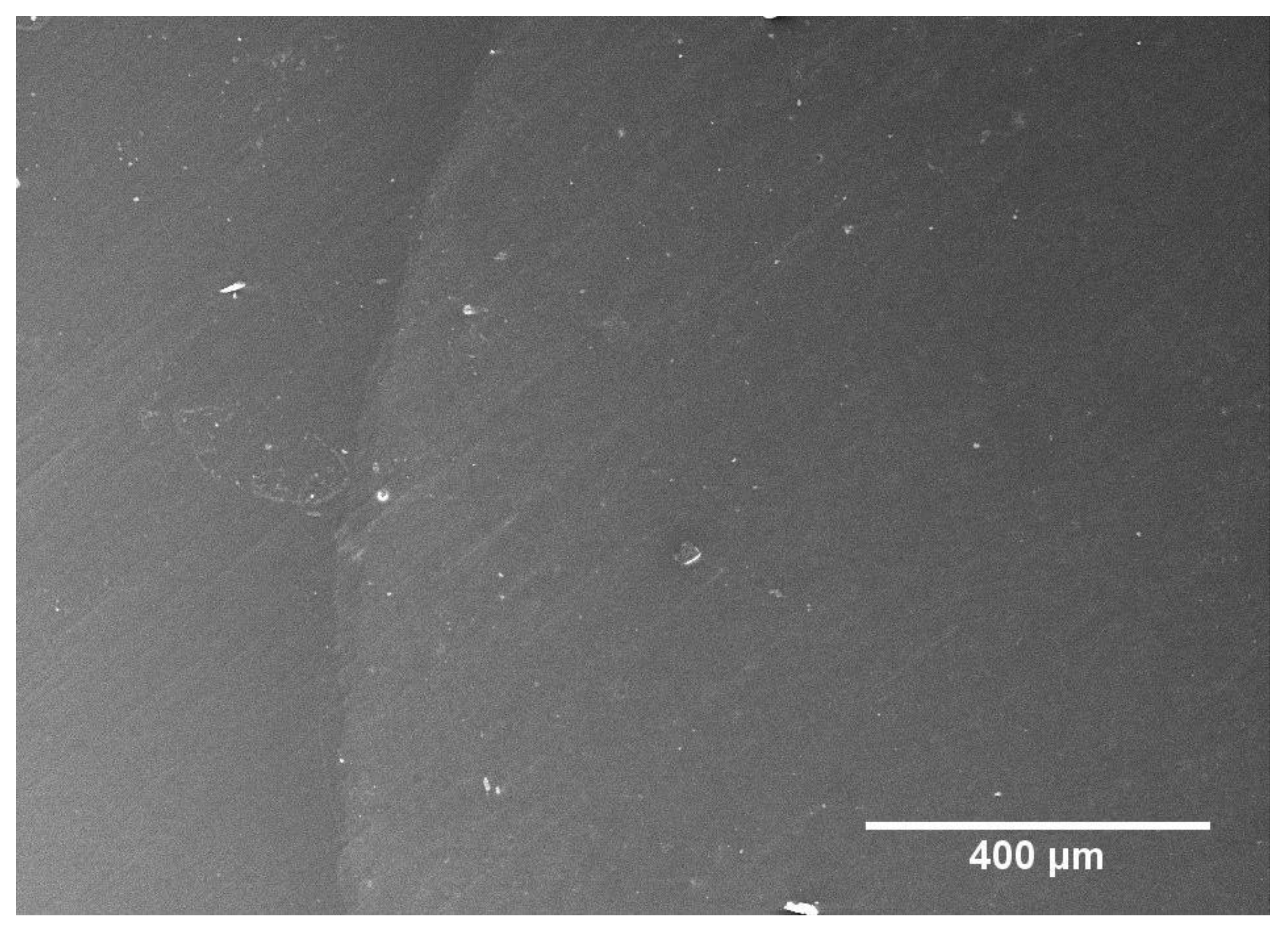Impact of Different Etching Strategies on Margin Integrity of Conservative Composite Restorations in Demineralized Enamel
Abstract
1. Introduction
2. Materials and Methods
2.1. Specimen Preparation and Demineralization
2.2. Adhesive Pretreatment
2.3. Restoration and Thermocycling
2.4. Assessment of Margin Integrity
2.5. Statistical Analysis
3. Results
4. Discussion
5. Conclusions
Author Contributions
Funding
Conflicts of Interest
References
- Tauböck, T.T.; Buchalla, W.; Hiltebrand, U.; Roos, M.; Krejci, I.; Attin, T. Influence of the interaction of light- and self-polymerization on subsurface hardening of a dual-cured core build-up resin composite. Acta Odontol. Scand. 2011, 69, 41–47. [Google Scholar] [CrossRef]
- Wegehaupt, F.J.; Tauböck, T.T.; Attin, T. Durability of the anti-erosive effect of surfaces sealants under erosive abrasive conditions. Acta Odontol. Scand. 2013, 71, 1188–1194. [Google Scholar] [CrossRef]
- Tauböck, T.T.; Marovic, D.; Zeljezic, D.; Steingruber, A.D.; Attin, T.; Tarle, Z. Genotoxic potential of dental bulk-fill resin composites. Dent. Mater. 2017, 33, 788–795. [Google Scholar] [CrossRef]
- Wiegand, A.; Credé, A.; Tschammler, C.; Attin, T.; Tauböck, T.T. Enamel wear by antagonistic restorative materials under erosive conditions. Clin. Oral Investig. 2017, 21, 2689–2693. [Google Scholar] [CrossRef] [PubMed]
- Tauböck, T.T.; Jäger, F.; Attin, T. Polymerization shrinkage and shrinkage force kinetics of high- and low-viscosity dimethacrylate- and ormocer-based bulk-fill resin composites. Odontology 2019, 107, 103–110. [Google Scholar] [CrossRef] [PubMed]
- Deari, S.; Wegehaupt, F.J.; Tauböck, T.T.; Attin, T. Influence of different pretreatments on the microtensile bond strength to eroded dentin. J. Adhes. Dent. 2017, 19, 147–155. [Google Scholar]
- Rizk, M.; Pohle, A.; Dieckmann, P.; Tauböck, T.T.; Biehl, R.; Wiegand, A. Mineral precipitation, polymerization properties and bonding performance of universal dental adhesives doped with polyhedral oligomeric silsesquioxanes. Int. J. Adhes. Adhes. 2020, 100, 102573. [Google Scholar] [CrossRef]
- De Almeida Neves, A.; Coutinho, E.; Cardoso, M.V.; Lambrechts, P.; Van Meerbeek, B. Current concepts and techniques for caries excavation and adhesion to residual dentin. J. Adhes. Dent. 2011, 13, 7–22. [Google Scholar]
- Calheiros, F.C.; Sadek, F.T.; Braga, R.R.; Cardoso, P.E. Polymerization contraction stress of low-shrinkage composites and its correlation with microleakage in class V restorations. J. Dent. 2004, 32, 407–412. [Google Scholar] [CrossRef] [PubMed]
- Totiam, P.; Gonzalez-Cabezas, C.; Fontana, M.R.; Zero, D.T. A new in vitro model to study the relationship of gap size and secondary caries. Caries Res. 2007, 41, 467–473. [Google Scholar] [CrossRef] [PubMed]
- Frankenberger, R.; Tay, F.R. Self-etch vs etch-and-rinse adhesives: Effect of thermo-mechanical fatigue loading on marginal quality of bonded resin composite restorations. Dent. Mater. 2005, 21, 397–412. [Google Scholar] [CrossRef] [PubMed]
- Van Meerbeek, B.; Van Landuyt, K.; De Munck, J.; Hashimoto, M.; Peumans, M.; Lambrechts, P.; Yoshida, Y.; Inoue, S.; Suzuki, K. Technique-sensitivity of contemporary adhesives. Dent. Mater. J. 2005, 24, 1–13. [Google Scholar] [CrossRef] [PubMed]
- Yazici, A.R.; Yildirim, Z.; Ertan, A.; Ozgunaltay, G.; Dayangac, B.; Antonson, S.A.; Antonson, D.E. Bond strength of one-step self-etch adhesives and their predecessors to ground versus unground enamel. Eur. J. Dent. 2012, 6, 280–286. [Google Scholar] [CrossRef] [PubMed]
- Körner, P.; Sulejmani, A.; Wiedemeier, D.B.; Attin, T.; Tauböck, T.T. Demineralized enamel reduces margin integrity of self-etch, but not of etch-and-rinse bonded composite restorations. Odontology 2019, 107, 308–315. [Google Scholar] [CrossRef] [PubMed]
- Frankenberger, R.; Lohbauer, U.; Roggendorf, M.J.; Naumann, M.; Taschner, M. Selective enamel etching reconsidered: Better than etch-and-rinse and self-etch? J. Adhes. Dent. 2008, 10, 339–344. [Google Scholar]
- Taschner, M.; Nato, F.; Mazzoni, A.; Frankenberger, R.; Krämer, N.; Di Lenarda, R.; Petschelt, A.; Breschi, L. Role of preliminary etching for one-step self-etch adhesives. Eur. J. Oral Sci. 2010, 118, 517–524. [Google Scholar] [CrossRef] [PubMed]
- Körner, P.; El Gedaily, M.; Attin, R.; Wiedemeier, D.B.; Attin, T.; Tauböck, T.T. Margin integrity of conservative composite restorations after resin infiltration of demineralized enamel. J. Adhes. Dent. 2017, 19, 483–489. [Google Scholar]
- Buskes, J.A.; Christoffersen, J.; Arends, J. Lesion formation and lesion remineralization in enamel under constant composition conditions. A new technique with applications. Caries Res. 1985, 19, 490–496. [Google Scholar] [CrossRef]
- Groddeck, S.; Attin, T.; Tauböck, T.T. Effect of cavity contamination by blood and hemostatic agents on marginal adaptation of composite restorations. J. Adhes. Dent. 2017, 19, 259–264. [Google Scholar]
- Paganini, A.; Attin, T.; Tauböck, T.T. Margin integrity of bulk-fill composite restorations in primary teeth. Materials 2020, 13, 3802. [Google Scholar] [CrossRef]
- Frankenberger, R.; Hehn, J.; Hajtó, J.; Krämer, N.; Naumann, M.; Koch, A.; Roggendorf, M.J. Effect of proximal box elevation with resin composite on marginal quality of ceramic inlays in vitro. Clin. Oral Investig. 2013, 17, 177–183. [Google Scholar] [CrossRef] [PubMed]
- R Core Team. R: A Language and Environment for Statistical Computing; R Foundation for Statistical Computing: Vienna, Austria, 2016; Available online: https://www.R-project.org/ (accessed on 3 April 2020).
- Pohlert, T. The Pairwise Multiple Comparison of Mean Ranks Package (PMCMR). R Package. 2014. Available online: https://CRAN.R-project.org/package=PMCMR (accessed on 3 April 2020).
- Park, J.; Chang, J.; Ferracane, J.; Lee, I.B. How should composite be layered to reduce shrinkage stress: Incremental or bulk filling? Dent. Mater. 2008, 24, 1501–1505. [Google Scholar] [CrossRef] [PubMed]
- Tauböck, T.T.; Feilzer, A.J.; Buchalla, W.; Kleverlaan, C.J.; Krejci, I.; Attin, T. Effect of modulated photo-activation on polymerization shrinkage behavior of dental restorative resin composites. Eur. J. Oral Sci. 2014, 122, 293–302. [Google Scholar] [CrossRef] [PubMed]
- Spencer, P.; Ye, Q.; Park, J.; Topp, E.M.; Misra, A.; Marangos, O.; Wang, Y.; Bohaty, B.S.; Singh, V.; Sene, F.; et al. Adhesive/Dentin interface: The weak link in the composite restoration. Ann. Biomed. Eng. 2010, 38, 1989–2003. [Google Scholar] [CrossRef]
- Yassen, G.H.; Platt, J.A.; Hara, A.T. Bovine teeth as substitute for human teeth in dental research: A review of literature. J. Oral. Sci. 2011, 53, 273–282. [Google Scholar] [CrossRef]
- Magalhães, A.C.; Moron, B.M.; Comar, L.P.; Wiegand, A.; Buchalla, W.; Buzalaf, M.A. Comparison of cross-sectional hardness and transverse microradiography of artificial carious enamel lesions induced by different demineralising solutions and gels. Caries Res. 2009, 43, 474–483. [Google Scholar] [CrossRef]
- Jia, L.; Stawarczyk, B.; Schmidlin, P.R.; Attin, T.; Wiegand, A. Effect of caries infiltrant application on shear bond strength of different adhesive systems to sound and demineralized enamel. J. Adhes. Dent. 2012, 14, 569–574. [Google Scholar]
- Wiegand, A.; Stawarczyk, B.; Buchalla, W.; Tauböck, T.T.; Özcan, M.; Attin, T. Repair of silorane composite–Using the same substrate or a methacrylate-based composite? Dent. Mater. 2012, 28, e19–e25. [Google Scholar] [CrossRef]
- Krejci, I.; Duc, O.; Dietschi, D.; de Campos, E. Marginal adaptation, retention and fracture resistance of adhesive composite restorations on devital teeth with and without posts. Oper. Dent. 2003, 28, 127–135. [Google Scholar]
- Kubo, S.; Kawasaki, K.; Yokota, H.; Hayashi, Y. Five-year clinical evaluation of two adhesive systems in non-carious cervical lesions. J. Dent. 2006, 34, 97–105. [Google Scholar] [CrossRef]
- Sato, T.; Takagaki, T.; Ikeda, M.; Nikaido, T.; Burrow, M.F.; Tagami, J. Effects of selective phosphoric acid etching on enamel using “no-wait” self-etching adhesives. J. Adhes. Dent. 2018, 20, 407–415. [Google Scholar] [PubMed]
- Grégoire, G.; Ahmed, Y. Evaluation of the enamel etching capacity of six contemporary self-etching adhesives. J. Dent. 2007, 35, 388–397. [Google Scholar] [CrossRef] [PubMed]
- Szesz, A.; Parreiras, S.; Reis, A.; Loguercio, A. Selective enamel etching in cervical lesions for self-etch adhesives: A systematic review and meta-analysis. J. Dent. 2016, 53, 1–11. [Google Scholar] [CrossRef] [PubMed]
- Nazari, A.; Shimada, Y.; Sadr, A.; Tagami, J. Pre-etching vs. grinding in promotion of adhesion to intact enamel using self-etch adhesives. Dent. Mater. J. 2012, 31, 394–400. [Google Scholar] [CrossRef]
- Souza-Junior, E.J.; Prieto, L.T.; Araújo, C.T.; Paulillo, L.A. Selective enamel etching: Effect on marginal adaptation of self-etch LED-cured bond systems in aged Class I composite restorations. Oper. Dent. 2012, 37, 195–204. [Google Scholar] [CrossRef]
- Nicolas-Silvente, A.I.; Chiva-Garcia, F.; Sanchez-Perez, A. The effect of dental enamel pre-etching for self-etching adhesives according to their primer pH: An in vitro bond strength, etching pattern and adhesive failure evaluation. J. Dent. Open Access 2020, 2. [Google Scholar] [CrossRef]
- Van Meerbeek, B.; Yoshihara, K.; Yoshida, Y.; Mine, A.; De Munck, J.; Van Landuyt, K.L. State of the art of self-etch adhesives. Dent. Mater. 2011, 27, 17–28. [Google Scholar] [CrossRef]
- Barkmeier, W.W.; Erickson, R.L.; Kimmes, N.S.; Latta, M.A.; Wilwerding, T.M. Effect of enamel etching time on roughness and bond strength. Oper. Dent. 2009, 34, 217–222. [Google Scholar] [CrossRef]
- Bakhsh, T.A.; Sadr, A.; Shimada, Y.; Mandurah, M.M.; Hariri, I.; Alsayed, E.Z.; Tagami, J.; Sumi, Y. Concurrent evaluation of composite internal adaptation and bond strength in a class-I cavity. J. Dent. 2013, 41, 60–70. [Google Scholar] [CrossRef]
- Makishi, P.; Thitthaweerat, S.; Sadr, A.; Shimada, Y.; Martins, A.L.; Tagami, J.; Giannini, M. Assessment of current adhesives in class I cavity: Nondestructive imaging using optical coherence tomography and microtensile bond strength. Dent. Mater. 2015, 31, e190–e200. [Google Scholar] [CrossRef]
- Tay, F.R.; Frankenberger, R.; Krejci, I.; Bouillaguet, S.; Pashley, D.H.; Carvalho, R.M.; Lai, C.N. Single-bottle adhesives behave as permeable membranes after polymerization. I. In vivo evidence. J. Dent. 2004, 32, 611–621. [Google Scholar] [CrossRef] [PubMed]
- Tay, F.R.; Lai, C.N.; Chersoni, S.; Pashley, D.H.; Mak, Y.F.; Suppa, P.; Prati, C.; King, N.M. Osmotic blistering in enamel bonded with one-step self-etch adhesives. J. Dent. Res. 2004, 83, 290–295. [Google Scholar] [CrossRef] [PubMed]
- Van Landuyt, K.L.; Yoshida, Y.; Hirata, I.; Snauwaert, J.; De Munck, J.; Okazaki, M.; Suzuki, K.; Lambrechts, P.; Van Meerbeek, B. Influence of the chemical structure of functional monomers on their adhesive performance. J. Dent. Res. 2008, 87, 757–761. [Google Scholar] [CrossRef] [PubMed]
- Li, N.; Nikaido, T.; Takagaki, T.; Sadr, A.; Makishi, P.; Chen, J.; Tagami, J. The role of functional monomers in bonding to enamel: Acid-base resistant zone and bonding performance. J. Dent. 2010, 38, 722–730. [Google Scholar] [CrossRef]
- Carrilho, E.; Cardoso, M.; Marques Ferreira, M.; Marto, C.M.; Paula, A.; Coelho, A.S. 10-MDP based dental adhesives: Adhesive interface characterization and adhesive stability–A systematic review. Materials 2019, 12, 790. [Google Scholar] [CrossRef]
- Scribante, A.; Poggio, C.; Gallo, S.; Riva, P.; Cuocci, A.; Carbone, M.; Arciola, C.R.; Colombo, M. In vitro re-hardening of bleached enamel using mineralizing pastes: Toward preventing bacterial colonization. Materials 2020, 13, 818. [Google Scholar] [CrossRef]




| Adhesive | Composition | pH | LOT No. | Manufacturer |
|---|---|---|---|---|
| iBond Self Etch | UDMA, 4-META, glutaraldehyde, acetone, water, photo-initiators, stabilizers | 1.6–1.8 | 010902 | Kulzer, Hanau, Germany |
| Clearfil SE Bond | Primer: 10-MDP, HEMA, hydrophilic aliphatic dimethacrylate, di-camphorquinone, DEPT, water | 2 | CB0279 | Kuraray, Osaka, Japan |
| Bonding: 10-MDP, Bis-GMA, HEMA, hydrophobic aliphatic dimethacrylate, di-camphorquinone, DEPT, colloidal silica | C50447 |
© 2020 by the authors. Licensee MDPI, Basel, Switzerland. This article is an open access article distributed under the terms and conditions of the Creative Commons Attribution (CC BY) license (http://creativecommons.org/licenses/by/4.0/).
Share and Cite
El Gedaily, M.; Attin, T.; Wiedemeier, D.B.; Tauböck, T.T. Impact of Different Etching Strategies on Margin Integrity of Conservative Composite Restorations in Demineralized Enamel. Materials 2020, 13, 4500. https://doi.org/10.3390/ma13204500
El Gedaily M, Attin T, Wiedemeier DB, Tauböck TT. Impact of Different Etching Strategies on Margin Integrity of Conservative Composite Restorations in Demineralized Enamel. Materials. 2020; 13(20):4500. https://doi.org/10.3390/ma13204500
Chicago/Turabian StyleEl Gedaily, Mohamed, Thomas Attin, Daniel B. Wiedemeier, and Tobias T. Tauböck. 2020. "Impact of Different Etching Strategies on Margin Integrity of Conservative Composite Restorations in Demineralized Enamel" Materials 13, no. 20: 4500. https://doi.org/10.3390/ma13204500
APA StyleEl Gedaily, M., Attin, T., Wiedemeier, D. B., & Tauböck, T. T. (2020). Impact of Different Etching Strategies on Margin Integrity of Conservative Composite Restorations in Demineralized Enamel. Materials, 13(20), 4500. https://doi.org/10.3390/ma13204500







